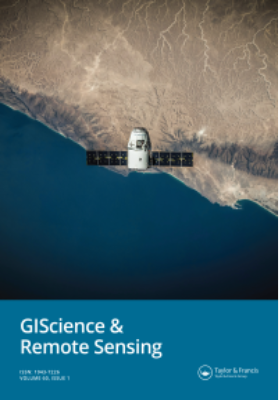Snow detection in alpine regions with Convolutional Neural Networks: discriminating snow from cold clouds and water body
IF 6
2区 地球科学
Q1 GEOGRAPHY, PHYSICAL
引用次数: 2
Abstract
ABSTRACT Accurately monitoring the variation of snow cover from remote sensing is vital since it assists in various fields including prediction of floods, control of runoff values, and the ice regime of rivers. Spectral indices methods are traditional ways to realize snow segmentation, including the most common one – the Normalized Difference Snow Index (NDSI), which utilizes the combination of green and short-wave infrared (SWIR) bands. In addition, spectral indices methods heavily depend on the optimal threshold to determine the accuracy, making it time-consuming to find optimal values for different places. Convolutional neural networks ensemble model with DeepLabV3+ was employed as sub-models for snow segmentation using (Sentinel-2), which aims to distinguish clouds and water body from snow. The imagery dataset generated in this article contains sites in global alpine regions such as Tibetan Plateau in China, the Alps in Switzerland, Alaska in the United States, Southern Patagonian Icefield in Chile, Tsylos Provincial Park, Tatsamenie Peak, and Dalton Peak in Canada. To overcome the limitation of DeepLabV3+, which only accepts three channels as input features, and the need to use six features: green, red, blue, near-infraRed, SWIR, and NDSI, 20 three-channel DeepLabV3+ sub-models, were constructed with different combinations of three features and then ensembled together. The proposed ensemble model showed superior performance than benchmark spectral indices method, with mIoU values ranging from 0.8075 to 0.9538 in different test sites. The results of this project contribute to the development of automated snow segmentation tools to assist earth observation applications.基于卷积神经网络的高寒地区雪检测:区分冷云和水体中的雪
从遥感中准确监测积雪变化至关重要,因为它有助于洪水预测、径流值控制和河流冰况等各个领域。光谱指数方法是实现积雪分割的传统方法,其中最常用的是利用绿色波段和短波红外波段相结合的归一化差雪指数(NDSI)。此外,光谱指数方法在很大程度上依赖于最优阈值来确定精度,这使得寻找不同地点的最优值非常耗时。采用deepplabv3 +卷积神经网络集成模型作为子模型,使用(Sentinel-2)进行雪分割,目的是将云和水体与雪区分开来。本文生成的图像数据集包含全球高山地区的站点,如中国的青藏高原、瑞士的阿尔卑斯山、美国的阿拉斯加、智利的南巴塔哥尼亚冰原、Tsylos省立公园、Tatsamenie峰和加拿大的道尔顿峰。为克服DeepLabV3+只接受3通道作为输入特征,需要使用绿、红、蓝、近红外、SWIR、NDSI 6个特征的局限性,构建了3个特征不同组合的20个三通道DeepLabV3+子模型,并将其组合在一起。综上模型的mIoU值在0.8075 ~ 0.9538之间,优于基准光谱指数方法。该项目的成果有助于开发自动雪分割工具,以协助地球观测应用。
本文章由计算机程序翻译,如有差异,请以英文原文为准。
求助全文
约1分钟内获得全文
求助全文
来源期刊
CiteScore
11.20
自引率
9.00%
发文量
84
审稿时长
6 months
期刊介绍:
GIScience & Remote Sensing publishes original, peer-reviewed articles associated with geographic information systems (GIS), remote sensing of the environment (including digital image processing), geocomputation, spatial data mining, and geographic environmental modelling. Papers reflecting both basic and applied research are published.

 求助内容:
求助内容: 应助结果提醒方式:
应助结果提醒方式:


